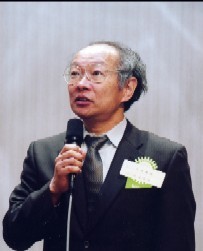A Problem and the Future of the World Cultural Heritage ĄĄ
September 29th,2004
Professor of the Consolidated Human Sciences Institute,
Leader of the World Cultural Heritage Study Team
Dr. Kenichiro Hidaka,
 As a basic premise, we state that humans seek things that do not change in time as themselves.
As a basic premise, we state that humans seek things that do not change in time as themselves.
When we visit our old school, we find that the trees have grown and schoolrooms standing we feel an attraction for old times. On the other hand should they have disappeared we feel a loneliness. Therefore to keep intact things which have not changed is important as they play a vital role in human existence.The term World Cultural Heritage is now attracting attention, but the effort to preserve such is not new.
In 1907, the rules for land warfare were drawn up as a treaty in order to prevent reckless destruction of historical structures, hospitals, etc.If these rules were strictly adhered to, the destruction we have seen would not have happened. World War ĩ caused widespread destruction following which came a period of reconstruction.
This gave birth to 3 streams of thought. One was to keep the destroyed structures as they were as a reminder of the horrors of war. The second was to rebuild the city or town on a new plan. The third was to rebuild as near as possible to resemble the original. The second does not allow for preservation, but the first and third do. After the Second World War, the third policy was adopted in various places, such a Ypress in Belgium.
Following World War ĩ, the League of Nations organized an International Committee on Intellectual Cooperation which later became the UNESCO. In 1926 he International Museum Secretariat was formed, and in 1930-31 a conference for the preservation of art works and structures took place in Rome and Athens. Because the world war had taken place in Europe where the destruction also happened, such efforts were centered in Europe. In 1941, the French architect Le Corbusier created the Athens Charter where he called for the preservation of historical objects.
After World War ķ, Warsaw, which had largely been destroyed by the war, rebuilt the old city from remaining blueprints, and this rebuilt old city was designated a World Cultural Heritage in 1978.
Since 1950, internal conflict, guerilla warfare and the intervention of the major powers has made warfare a complicated affair. UNESCO and ICOM (International Council of Museums) have been given a new job for their activities.
In 1956, and international center for the maintenance and repair of cultural assets (ICCROM) was established, and in 1965 and international historic site conference (ICOMCS) was formed in Warsaw and Krakow. In 1955, the Nubian temples were removed to high ground to save them from the waters resulting from the Aswan dam. UNESCO has been quite successful, but on the other hand the developing nations rely on UNESCO overly, while some place more importance on tourism than preservation. There were no rules in this respect.
In 1965 the Venice Charter was adopted and the World Cultural Heritage Treaty came into existence. In November 1972 a Treaty on the Preservation of the WorldĄĮs Cultural and National Heritage was adopted, making it possible to take steps to preserve nature.
The term world signifies that the entire world is responsible and that is applicable both in war and peace.As steps to be taken, they are 1.Screening for registration 2.Listing 3.Designating endangered heritages with means of protection 4.Creaation of a World Cultural Heritage Fund 5. Establishment of a World Cultural Heritage Center. In order to qualify, the heritage in question must have an Outstanding Universal Value together with a Management Plan. In the future, multi-nation assets such as the Silk Road or the Path of Buddhism must be considered. It is necessary to train persons to do this work and we at Tsukuba University have opened a World Heritage Class in our Post Graduate MasterĄĮs Degree Course for this purpose.